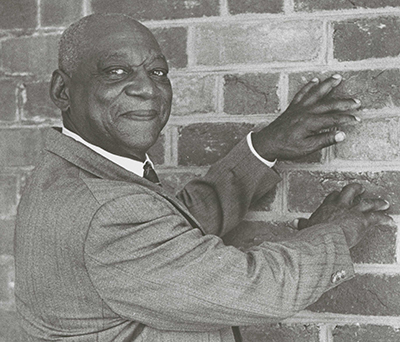Rising from the son of a former slave to international recognition for his brickmaking craftmanship, George Black made an impact on Winston-Salem and communities beyond. He made bricks for more than 80 years and taught the craft well into his 90s. Even at age 100, the inner spark that fired his long brickmaking career remained strong.
“Part of the legacy of George Black is in buildings,” Emily Herring Wilson says in the book, “George Henry Black: 100 Years,” published in 1979. Quoting from hours of conversations they shared, she writes:
“Today when George Black goes for a ride in Winston-Salem, he points out, ‘I made them bricks there’ or ‘My brick are in all them branch banks’ or ‘That chimney is my brick.’ Recently when one of the six-brick molds was borrowed from his house for an exhibit, he was reluctant to let it go: ‘You bring that back, hear, come warm weather. I’ll be making some brick when it’s warm weather.’”
After George Black died in 1980, at the age of 101, tributes began to establish his place in history. In 2003, the N.C. General Assembly approved a joint resolution honoring his life, and Forsyth County officials placed a bronze statue of him outside the Forsyth County Government Center.
His home and brickyard at 111 Dellabrook Road in Winston-Salem were listed on the National Register of Historic Places in 2000. The city put up a streetside marker in 2007, and the property was designated a Forsyth County Local Historic Landmark in 2011.
 Preserving the Handcrafted Tradition
Preserving the Handcrafted Tradition
George Black was born in Randolph County on February 15, 1879. At age 10, he walked 50 miles with his father and brother to Winston-Salem, where they got jobs hauling bricks for Hedgecock and Hines Brickyard. He later learned the craft of making bricks by hand in a wooden mold called a mud mill.
When his employer gave him an old mud mill for firewood, George Black refurbished it and began making his own bricks.
In 1910, he opened his first brickyard. Supporting his growing family may have fueled his ambition. He and his wife, Martha Jane Hampton, married in 1897 and had eight children. Everyone in the family eventually worked in the brick business.
By the 1920s, George Black had a reputation for making durable, high-quality bricks. Over the decades, they were used for homes, banks, churches, hospitals and sidewalks. As machine-made bricks became standard, his traditional handmade bricks became preferred for restoration work, and they were used in Old Salem, Colonial Williamsburg, Charleston and Savannah. Reader’s Digest dubbed him “The Last Brickmaker in America.”
In 1971, North Carolina native Charles Kuralt featured George Black in his folksy “On the Road” series on CBS Evening News. National exposure led to the U.S. State Department hiring him to teach brickmaking in Guyana, South America. President Richard M. Nixon honored George Black at a White House reception.
 Each Brick a Piece of History
Each Brick a Piece of History
When Old Main was torn down in 1978, the historical significance was obvious. The 55-year-old brick building was outdated, surrounded by newer buildings, and set to be replaced with a steel and black glass-covered structure, which was dedicated as Watlington Hall in 1981 and remains today.
John Lynch and Richard Janeway, respective leaders of the hospital and the medical school at the time, encouraged Gary Fleming, then-assistant director of Development, to save some bricks for future generations. The demolition crew delivered the bricks to the Development office, located then in the basement of the Hanes Building.
“We didn’t have room to store the bricks, so I said, I’ll hold onto them and put them in my basement at home,” recalled Gary, who still lives at the same Buena Vista Road address.
The bricks remained there until Gary, who left his Development post in 1985, recently contacted medical center officials to return the bricks for use as mementos during the hospital’s Centennial celebration. One of the bricks will be included in a time capsule to be opened 100 years later.
Other medical center officials had also collected souvenir bricks in 1978, and one is mounted on a commemorative plaque that resides in the Coy C. Carpenter Library, along with photos and historical accounts of the original Baptist Hospital.
Today, that handmade mud brick remains as a symbol of deep community roots. As we mark the 100th birthday of Baptist Hospital, we recognize George Henry Black, a man who put as much care into making bricks as the care given to patients within the hospital’s walls.
References
- Emily Herring Wilson, “George Henry Black: 100 Years,” Urban Arts of the Arts Council Inc., Winston-Salem, N.C., 1979, Dorothy Carpenter Medical Archives, Coy C. Carpenter Library, Wake Forest University School of Medicine.
- Annette Scippio “Remembering a Local Hero - From Bricks to Fame,” Winston-Salem Chronicle, February 22, 1990, https://newspapers.digitalnc.org/lccn/sn85042324/1990-02-22/ed-1/seq-30/.
- “Remembering Old Main,” Dorothy Carpenter Medical Archives, Coy C. Carpenter Library, Wake Forest University School of Medicine, September 21, 2016.
- House Joint Resolution 1229, Session 2003, General Assembly of North Carolina, https://www.ncleg.net/sessions/2003/bills/house/html/h1229v1.html.
- “George Black House and Brickyard,” Forsyth County Historical Resources Commission, Historic Marker Program, https://www.cityofws.org/DocumentCenter/View/4040/13---George-Black-House-and-Brickyard-PDF.
